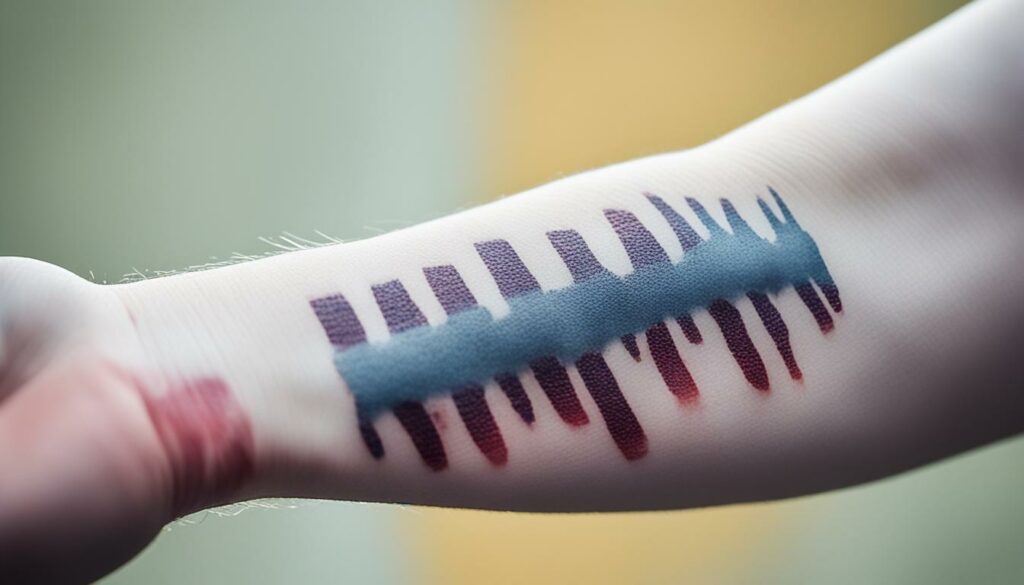Understanding Why Teens Cut Themselves
Self-harm, specifically cutting, has become a distressing issue among adolescents. It affects a significant percentage of teenagers and college students in the United States. It’s crucial to grasp the reasons behind this behavior to provide the right support and prevention strategies.
Recent studies show that approximately 17% of teenagers and 15% of college students in the United States engage in self-harming behaviors. Typically, self-harm begins during early adolescence, at around 11 to 14 years old, and often ceases by the mid- to late-30s. Although self-harm may not always indicate suicidal thoughts, there is a significant link between self-harm and suicide if left untreated.
This article will delve into the reasons why teens engage in self-harm, how to recognize the signs, and the different types of self-harm. We will also explore the impact of social media on self-harm behavior, as well as the risks and warning signs associated with self-harm progressing to suicidal thoughts. Finally, we will discuss the importance of seeking help and treatment options, providing support to teens who self-harm, and understanding self-harm as a symptom of underlying issues.
Key Takeaways:
- Self-harm is a prevalent issue among adolescents, affecting approximately 17% of teenagers and 15% of college students in the United States.
- Self-harming behaviors usually start in early adolescence, around the ages of 11 to 14, and often stop by the mid- to late-30s.
- Understanding the reasons behind teenage self-harm is essential to provide support and prevention strategies.
- Self-harm is primarily used by adolescents for emotional regulation, offering temporary relief from intense emotions.
- Recognizing signs of self-harm can be challenging, as most teenagers hide their injuries.
The Truth About Self-Harm
Understanding the reasons behind self-harming behavior in teenagers is crucial in providing them with the necessary support and intervention. Self-harm, such as cutting, is primarily used by adolescents as a way to regulate their emotions.
Adolescents who self-harm often experience intense emotions or have difficulty tolerating distress. Injuring themselves provides temporary relief and makes them feel better in the moment. However, it is important to note that self-harm is not a healthy coping mechanism and should not be encouraged or normalized.
Teenagers who engage in self-harm require intervention and treatment to address the underlying issues contributing to their behaviors. It is essential to provide them with healthier coping strategies and help them develop the necessary skills to regulate their emotions in a more constructive manner.
“Self-harm provides temporary relief, but it is not a healthy coping mechanism.”
Recognizing the truth about self-harm is the first step toward understanding teenage self-injury and providing effective support and intervention.
Key Factors Contributing to Self-Harm in Teens:
| Reasons for Self-Harming Behavior in Teenagers |
|---|
| Intense emotions and difficulties with emotional regulation |
| Distress tolerance issues |
| Desire for temporary relief |
| Lack of healthy coping mechanisms |
Recognizing Signs of Self-Harm

Recognizing signs of self-harm in a loved one can be challenging, as many teenagers are skilled at hiding their injuries. Self-harm behaviors, such as cutting or burning, often occur in areas of the body that are covered by clothing. However, there are several signs that may indicate self-harming behavior:
- Repeated cuts: If you notice multiple cuts, especially in linear patterns or clusters, it could be a sign of self-harm.
- Excuses for injuries: Your loved one may come up with unconvincing explanations for injuries, such as blaming accidents or clumsiness.
- Wearing long sleeves in inappropriate settings: Individuals who self-harm may try to hide their injuries by wearing long sleeves, even in warm weather or situations where long sleeves are not necessary.
- Bloody tissues in the trash: Discovering bloody tissues or bandages in the trash could be an indication that your loved one is engaging in self-harm.
If you suspect that a teen may be self-harming, it’s crucial to approach the situation calmly and non-judgmentally. Start by expressing concern and providing a safe space for them to open up. Active listening and empathy are key in fostering open and constructive communication.
Types of Self-Harm
When it comes to self-harm, cutting is the most common form of non-suicidal self-injury among adolescents. This self-injury behavior involves using razors, knives, or other sharp objects to intentionally cut the skin. While cutting is prevalent, there are other forms of self-harm to be aware of:
- Burning: Some individuals may choose to burn themselves as a way to cope with emotional pain. This can involve using heated objects or deliberately exposing their skin to flames.
- Skin Picking: An individual may engage in skin picking, also known as dermatillomania, as a form of self-harm. This behavior involves continually picking at scabs, acne, or healthy skin until it breaks, resulting in wounds.
- Punching: In some cases, teens may resort to punching themselves or hitting objects to intentionally cause physical harm.
- Bone-Breaking: While less common, bone-breaking is an extreme form of self-harm where an individual intentionally fractures their own bones.
Understanding the various forms of self-harm is crucial in identifying and addressing the behavior effectively. By recognizing the specific methods used, appropriate interventions and treatment strategies can be implemented to support teenagers who engage in self-injury.
Reasons Why Teens Self-Harm
Understanding why teens engage in self-harm is essential in addressing their self-harming behavior. There are various reasons why adolescents resort to self-harm as a coping mechanism. These reasons include:
- Emotional regulation: Some teens engage in self-harm to cope with overwhelming emotions. It provides them with temporary relief and helps regulate their intense feelings.
- Creating emotions: In some cases, teenagers who feel numb or empty inside may self-harm to create emotions. The physical pain they experience can serve as a way to feel something when they are emotionally detached.
- Punishment: Self-harm can also be viewed as a form of self-punishment. Adolescents may engage in self-injury due to guilt, shame, or feelings of unworthiness. They believe they deserve the pain inflicted upon themselves.
- Communication of pain: For some teens, self-harm becomes a way to communicate their emotional pain when they struggle to express their feelings verbally. It serves as a visual representation of their internal struggles, allowing them to convey their distress to others.
Understanding the underlying reasons for teenage self-harm is vital to provide appropriate support and intervene effectively.
By acknowledging these causes, we can better empathize with and address the needs of teenagers who self-harm. It is important to approach them with compassion, understanding, and professional assistance.
The Role of Social Media

Social media has become an integral part of the lives of today’s teenagers. It offers an avenue for self-expression, connection, and community building. However, when it comes to self-harm behavior among teens, the impact of social media can be both positive and negative.
On one hand, social media platforms can serve as a space where teens find support and guidance. Online communities dedicated to mental health and self-harm recovery provide a sense of belonging and understanding. These platforms offer a safe space for teenagers to share their experiences, seek advice, and make positive choices towards recovery.
“Being part of an online support group has been incredibly helpful for me. I feel less alone and have learned healthier strategies to cope with my emotions.” – Sarah, 17
However, it’s essential to recognize that not all social media platforms promote positive messages. Some platforms may inadvertently normalize self-harm, leading vulnerable individuals to engage in such behaviors. The accessibility of explicit self-harm content on social media can be triggering for teens already struggling with self-harm, potentially exacerbating their condition.
Furthermore, the exposure to self-harm content on social media can contribute to the spread of self-harm behaviors. It may create a sense of emulation or curiosity among impressionable teenagers, leading them to experiment with self-harm as a coping mechanism.
The Impact of Social Media Visibility
Social media platforms have an incredible reach, making it important to consider the potential impact of self-harm content on a large scale. The exponential sharing and viral nature of content can result in the rapid dissemination of harmful ideas and behaviors. This can be damaging to vulnerable individuals who may feel compelled to engage in self-harm due to the influence of social media.
It is crucial for parents, caregivers, and educators to be aware of the role social media plays in the lives of teenagers and to actively monitor their online activities. Open communication, education, and providing alternative coping strategies are key in mitigating the negative impact of social media on self-harm behaviors.
| Pros | Cons |
|---|---|
|
|
The impact of social media on self-harm behavior in teens is a complex issue that requires a balanced approach. By understanding the potential risks and benefits, we can work towards creating a healthier online environment for our young people.
Risks and Warning Signs

While self-harm is typically not a direct suicide attempt, it is important to recognize that teenagers who engage in self-harm are at an increased risk of progressing to suicidal thoughts and behaviors. Identifying the warning signs and seeking help promptly can play a crucial role in preventing further harm.
Warning Signs to Look Out For
There are several indicators that self-harm may be progressing towards suicide risk in teenagers:
- Longer History of Self-Harming: Teens who have been engaging in self-harm for an extended period may be more susceptible to escalating their self-destructive behaviors.
- Using Multiple Methods of Self-Injury: When a teen starts experimenting with different methods of self-harm, it can be indicative of a deeper emotional distress and an increased vulnerability to suicidal behaviors.
- Feeling No Pain During Self-Harm: If a teenager reports feeling numb or experiencing a lack of pain during self-harm, it could suggest that they are desensitized to the severity of self-inflicted injury, which raises concerns for their overall well-being.
Recognizing these warning signs is crucial for parents, caregivers, and friends to intervene and seek appropriate help promptly. Early intervention can make a significant difference in ensuring the safety and well-being of teenagers at risk of self-harm progressing towards suicide.
“Identifying the warning signs of self-harm progressing to suicide is a critical step in preventing tragedies. By staying vigilant and providing timely support, we can help teenagers navigate the difficulties they are facing and keep them safe.”
Getting Help and Treatment Options

When a teen is engaging in self-harm, it’s crucial to seek help from a professional who specializes in adolescent mental health, such as a therapist or psychiatrist. Treatment options for self-harming behavior can vary depending on the individual’s needs and circumstances.
One effective form of therapy is dialectical behavior therapy (DBT), which focuses on developing skills for emotional regulation, distress tolerance, and interpersonal effectiveness. DBT combines individual therapy with group skills training to provide a comprehensive approach to treatment.
In some cases, family therapy may be beneficial, as it can help improve family communication and address any underlying family dynamics that may contribute to self-harm. Engaging the whole family in the treatment process can have a positive impact on the teen’s recovery.
In addition to therapy, medication may be prescribed if an underlying mental health condition, such as depression or anxiety, is present. These medications can help manage symptoms and support the overall treatment process.
It is essential to develop healthy coping strategies for teens who self-harm. Encouraging alternative ways to express and regulate emotions, such as through art, music, or physical activity, can provide healthier outlets. Building a support network of trusted friends, family members, or support groups can also be beneficial for teens to feel understood and supported.
Coping Strategies for Teen Self-Harm
Below are some coping strategies that may help teens who self-harm:
- Engage in physical activity or sports to release tension and boost mood.
- Practice deep breathing or relaxation exercises when feeling overwhelmed.
- Express emotions through writing in a journal or creating art.
- Listen to music that evokes positive emotions.
- Seek distractions such as reading a book, watching a movie, or engaging in a hobby.
- Build a healthy support system by confiding in trusted friends or family members.
- Reach out to helplines or support groups for anonymous support and guidance.
Remember, it’s essential for teens who self-harm to receive professional help and support to address the underlying issues contributing to their behavior. With the right treatment and coping strategies, teens can navigate their emotions more effectively and build a healthier, happier future.
Supporting Teens Who Self-Harm
Support and understanding from family members are essential for helping teens who engage in self-harm. Approaching the situation with empathy and open communication can create a safe environment where teenagers feel comfortable discussing their struggles. Collaborating with healthcare professionals is also crucial in providing comprehensive support.
Reducing stigma surrounding self-harm is essential in supporting teens on their journey to healing. Educating oneself and others about self-harm can help promote understanding and empathy. By destigmatizing self-harm, society can foster a more supportive environment where teenagers feel comfortable seeking help.
“Family support plays a vital role in helping teens who self-harm.”
Creating a safe and supportive environment at home is key to aiding the recovery process. This includes ensuring that the home environment is free from triggers that may contribute to self-harm, such as access to sharp objects or harmful substances. It is important to provide alternative coping strategies and encourage the development of healthy outlets for emotions, such as journaling, art, or physical exercise.
Table: Strategies for Supporting Teens Who Self-Harm
| Strategy | Description |
|---|---|
| Counseling | Seeking professional help from therapists or psychologists who specialize in adolescent mental health can provide teens with the necessary tools to cope with their emotions and develop healthier coping mechanisms. |
| Family therapy | Family therapy sessions can help improve communication, understanding, and support within the family unit. It allows family members to address underlying issues and work together towards recovery. |
| Support groups | Teens can benefit from joining support groups where they can connect with others who have experienced similar struggles. These groups provide a safe space to share experiences, gain support, and learn from others. |
| Safe and supportive environment | Creating a home environment that is safe, understanding, and free from triggers is crucial in supporting teens who self-harm. Removing objects that can be used for self-harm and encouraging the development of healthy coping strategies can provide a strong foundation for recovery. |
Supporting teens who self-harm requires a multi-faceted approach that involves collaboration with professionals, reducing stigma, and creating a safe and supportive environment. By addressing self-harming behavior in a sensitive and understanding manner, families can play a vital role in helping teens on their journey to recovery and healing.
The Impact of Stress on Teen Self-Harm
Stress is a significant factor that can contribute to self-harm in teenagers. Adolescence is a time of immense change and growth, and it often comes with increased academic pressure, social dynamics, and worries about the future. These stressors can become overwhelming, leading some teens to resort to self-harming behaviors as a way to cope.
Academic Pressure: The demands of school life, including exams, homework, and expectations from parents and teachers, can create immense stress for teenagers. The constant pressure to perform can lead to feelings of anxiety, inadequacy, and a desire to escape. Some teens may turn to self-harm as a maladaptive coping mechanism, providing temporary relief from the stress they experience.
Social Dynamics: Adolescence is a time of heightened social awareness, and fitting in or dealing with peer pressure can be incredibly challenging. Teens may feel overwhelmed by social expectations, fear of rejection, or bullying, leading them to self-harm as a way to release their emotions or gain a sense of control in their lives.
Family Relationships: Turmoil within family relationships, such as conflict, abuse, or dysfunction, can significantly contribute to teenage stress levels. Teens may use self-harm as a means of expressing their pain or as a cry for help, seeking attention from their family members or attempting to cope with the emotional turmoil they experience at home.
Worries about the Future: As teenagers transition to adulthood, they often face uncertainty about their future, including career choices, college applications, and financial stability. The pressure to make important life decisions can be overwhelming, leading some teens to resort to self-harming behaviors as a way to escape or cope with their anxiety about the unknown.
The Importance of Coping Strategies and Support
Helping teenagers develop healthy coping strategies to manage stress is essential in preventing self-harm behaviors. Encouraging open communication, teaching relaxation techniques, and promoting self-care activities like exercise, hobbies, or creative outlets can be effective in reducing stress levels. Providing emotional support, validating their feelings, and helping them explore healthier ways to cope with stress are crucial steps in promoting their well-being.
It’s important to remember that self-harm is not a solution or a healthy coping mechanism for stress. Seeking professional help from therapists or counselors who specialize in adolescent mental health is vital in addressing the underlying issues contributing to self-harming behaviors and equipping teens with the necessary tools to manage stress in a healthy way.
By addressing the impact of stress on teenage self-harm and providing support and guidance, we can create a safer and more understanding environment for teenagers to navigate the challenges they face during this critical stage of their lives.
Helpful Coping Strategies for Teenagers:
- Engaging in regular physical activity
- Practicing deep breathing and mindfulness techniques
- Maintaining a healthy sleep schedule
- Encouraging open communication with trusted individuals
- Exploring creative outlets such as art, music, or writing
- Establishing a routine and setting realistic goals
- Creating a support network of friends and family
Understanding Self-Harm as a Symptom
Self-harm is not a mental illness itself but rather a symptom that signals deeper underlying issues. Teens who self-harm often struggle with poor emotional regulation and lack healthy coping skills. Treating the underlying causes, such as depression, anxiety, or trauma, is crucial in addressing self-harm behaviors effectively.
| Underlying Causes | Treating Approaches |
|---|---|
| Depression | Psychotherapy, medication, supportive interventions |
| Anxiety | Cognitive-behavioral therapy, relaxation techniques, stress management |
| Trauma | Trauma-focused therapy, EMDR, group therapy |
“Understanding the root causes of self-harm is essential in providing effective treatment and support for teens. By addressing the underlying issues, we can help them develop healthier coping mechanisms and improve their overall well-being.” – Dr. Emily Thompson, Child Psychologist.
Conclusion
In conclusion, preventing self-harm in teens requires a comprehensive approach that focuses on support and prevention strategies. Understanding why teens engage in self-harm is a crucial first step in providing the necessary help and guidance. By recognizing the signs of self-harming behavior, such as repeated cuts or excuses for injuries, we can intervene early and offer the support that these teens desperately need.
Seeking help from professionals, such as therapists or psychiatrists, plays a vital role in treating self-harming behavior. Providing access to various treatment options, such as individual therapy, family therapy, and medication if needed, can address underlying mental health conditions and help teens develop healthy coping mechanisms.
Creating a supportive environment is also essential in the recovery process. By fostering open and non-judgmental communication, we can create a safe space where teens feel comfortable expressing their emotions and seeking help. It’s important to educate ourselves and others about self-harm to reduce the stigma surrounding this issue and offer the necessary support for those struggling with self-harm.
By combining all these strategies, we can work towards preventing self-harm in teens and ensuring their overall well-being. Together, let’s create a society where all teens feel heard, supported, and equipped with the tools they need to navigate life’s challenges in a healthy and positive way.
FAQ
Why do teenagers engage in self-harm?
Teenagers may engage in self-harm as a means of emotional regulation, temporary relief from overwhelming emotions, creating emotions when feeling numb or empty, or as a form of punishment or communication of their pain.
How can I recognize if a loved one is engaging in self-harm?
Look out for signs such as repeated cuts, excuses for injuries, wearing long sleeves in inappropriate settings, and the presence of bloody tissues in the trash.
What are the types of self-harm that teenagers typically engage in?
The most common form of self-harm among adolescents is cutting. Other less common forms include burning, skin picking, punching, and bone-breaking.
What are the reasons behind self-harming behavior in teenagers?
Teenagers may engage in self-harm due to intense emotions, difficulty tolerating distress, feeling empty inside, or a need for emotional release.
How does social media impact self-harm behavior in teens?
Social media can both positively and negatively influence self-harm behaviors. While some communities provide support, others can normalize and perpetuate self-harm, which may trigger vulnerable individuals.
What are the risks and warning signs for teens who self-harm?
Teens who self-harm are at higher risk of progressing to suicidal thoughts or behaviors. Warning signs include a longer history of self-harming, using multiple methods of self-injury, and feeling no pain during self-harm.
How can teenagers who self-harm seek help?
It is vital for teens who self-harm to seek help from professionals such as therapists or psychiatrists who can provide individual therapy, medication if necessary, and help develop healthy coping strategies.
How can I support a teenager who self-harms?
Approach the situation with empathy, understanding, and open communication. Collaborate with healthcare professionals, create a safe and supportive environment, and educate yourself and others to reduce stigma.
How does stress contribute to self-harm in teenagers?
Stress from academic pressure, social dynamics, family relationships, and worries about the future can contribute to overwhelming stress levels in teens, making them more vulnerable to self-harm behaviors.
Is self-harm a symptom of underlying issues?
Yes, self-harm is often a symptom that signals deeper underlying issues such as depression, anxiety, or trauma. Treating these underlying causes is key to addressing self-harming behaviors effectively.
What strategies can be used to prevent self-harm and support teenagers?
Preventing self-harm and supporting teenagers involves developing healthy coping skills, seeking professional help, creating a supportive environment, and reducing stigma associated with self-harm.







